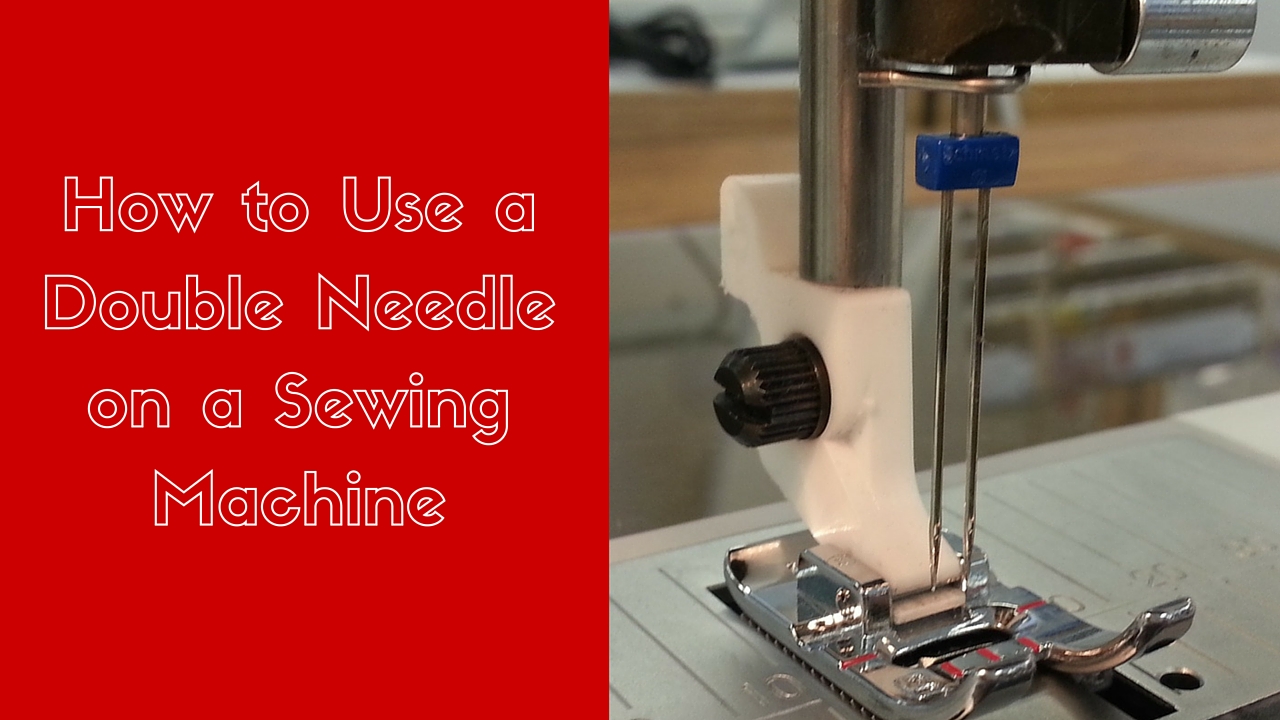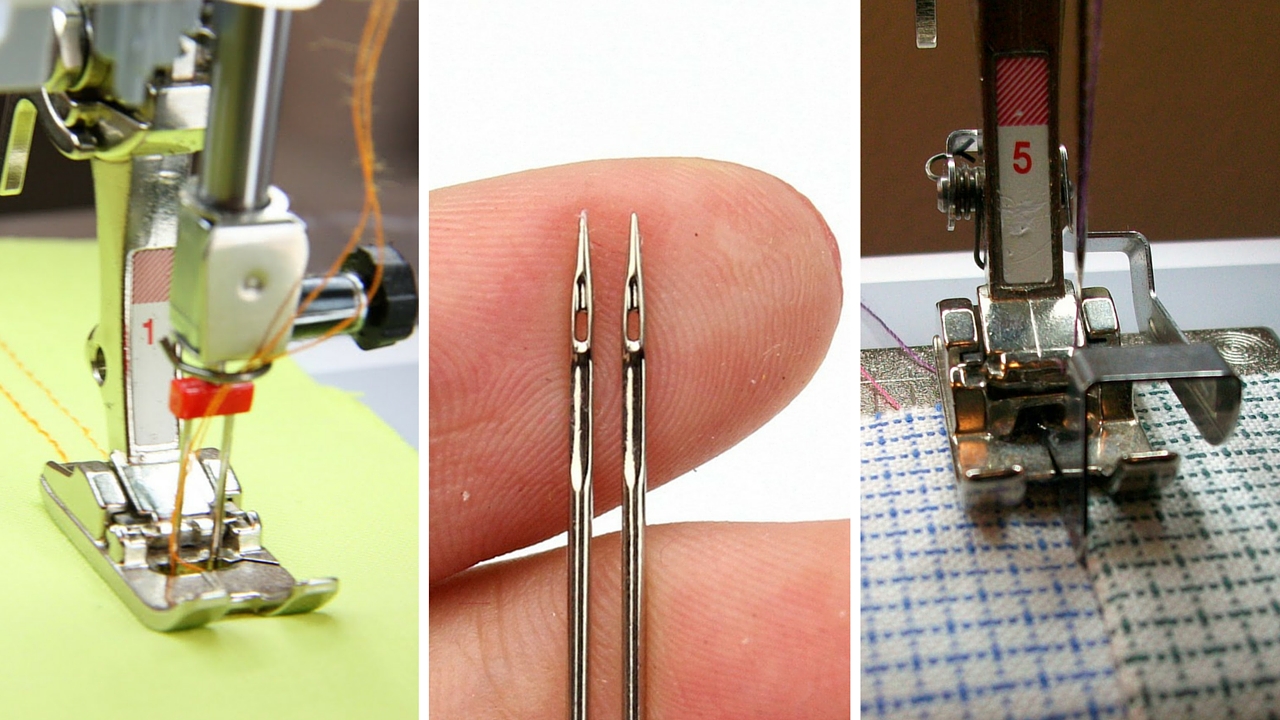
The readymade garments often have two neat stitches around the hems, necklines, cuffs, and sleeves. Most of them may be done on a cover stitch machine. It may have used a serger machine.
This incredibly satisfying professional look can be brought around using a double needle.
Knit clothes look professional with a double stitch on them. It may be difficult to get two straight lines perfectly placed all through when you try doing the single needle twice.
Two seams next to each other at a distance that you choose are easily achieved by a double needle.
Pre-requisites for using a double-needle
You may not be able to use a double needle on all sewing machines. If your sewing machine at least supports zig zag, you can use a double needle.
Double-needle
If your sewing machine can work with a double-needle, check the manual for threading instructions to know what size of double-needle fits into it.
A size of four double-needle means the gap between the two eyes of the needles is 4mm. If there is no information in the manual about the size, the best way to find it out is as follows.
Run a piece of waste cloth or paper without thread. The widest distance gives you the right size. If required, carry the paper to the shop and buy the correct size.
The wrong side of the double needle can spoil the throat plate or the footplate and the bobbin case. So you need to be careful about it.
Thread spools
You need two spools of threads. They need not be of the same color unless you are specific about it.
If you do not wish to buy two spools of threads of the same color and still want to use the same color, you can load the bobbin and use it as one of the spools.
Loading the bobbin is easy. Use a stick that can hold the bobbin not so tightly. Hold the end of the thread with one hand and the stick with the other. Run the sewing machine, and the thread just rolls on the bobbin.
Spool holders
You would need two spool holders to hold two spools of threads. You would have this option on most machines. But there are alternatives if your sewing machine does not have the option of two spool holders.
You can place both the spools on a single spool holder. But they may tangle and trouble you.
You can use the bobbin winder shaft for one of the spools. You can also drag the overlock close enough so that you can use its spool.
To create a spool holder, cut a piece of the dowel. Make sure the length of the dowel is long enough to fit in the spool of thread. Tape the dowel at the corner of the sewing machine at a height just enough to allow the spool to rotate freely.
Footplate
Make sure the double-needle passes through the footplate. You should cautiously use the zig-zag presser foot if you do not have the right footplate with a wide enough opening to allow both the needles.
The zig-zag presser foot has a wide mouth so that the double-needle can easily move back and forth.
With these, you are ready to spin the wheel and create a double stitch that makes your garment look similar to the shop-bought dress.

Threading the double-needle
Replace your regular needle with the double needle. It has no other special method. Just a regular needle change procedure would do. The double needle has a top post with two needles stuck into it.
Place the top post securely in the needle space. Screw it tight once the top post goes in as much as it can.
Use the regular upper thread and thread the left eye of the double-needle in a normal way. To thread the second thread from the second spool, you have two ways.
You can either skip passing the thread through the needle bar or hold the two ends of both the threads and thread them as if they were one thread and finally separate the thread just before passing them into the eyes of the needles.
If your sewing machine supports a double needle, it would have two separate holes on either side of the needlepoint. Pass the two threads in the right and left holes before passing them into the two eyes of the double needle.
Stitching with the double-needle
You can make all the necessary adjustments, such as the stitch length as you do in normal stitching. Place the fabric with the right side of it, facing upwards while sewing.
The right side of the fabric has two neat and perfectly straight and parallel lines of the stitch, while the wrong side has a kind of zig-zag pattern.
Advantages of double stitching
The double-needle stitching with a lengthy little stitch helps to skip the knit fabric and does not pull the fabric too much. It also allows a bit of stretch to the cloth, which is useful, especially in knit clothing.
Apart from the readymade quality stitching style, it can also be used as a decorative stitch. Two parallel straight lines of stitch can give a glam look to the hems.
It avoids the use of a serger or any special stitching to give a finishing look. New learners can experiment with a waste cloth and try different looks with the double needle.
It can be used for making bags, quilting, or for hot sewing pads, which need two lines of straight stitches. It is as easy as the regular stitch with minor changes in getting it ready for stitching.
Using a double-needle on your sewing machine gives homemade satisfaction with ready-made finishing quality. With so many advantages, the double-needle must have already caught your attention.
I hope this article helps you as a guide giving you some useful tips to use the double needle and have fun with stitching.
I’m looking to start making my own baseball caps. I’m curious if you could suggest any sewing machines that can work with double needles? I’m looking towards industrial ones – but if you know of any regular machines that can do it, i’m very interested.
My own point of view, “Brother cs6000i 60-Stitch Computerized Sewing Machine” is best double needles regular sewing machine. You can see related youtube video in here, https://www.youtube.com/watch?v=W3EDZuUISQo